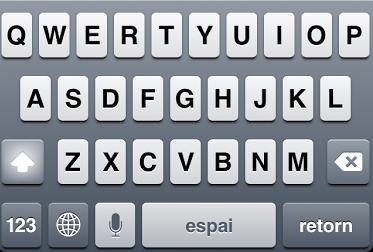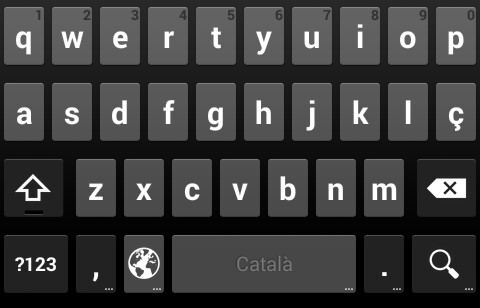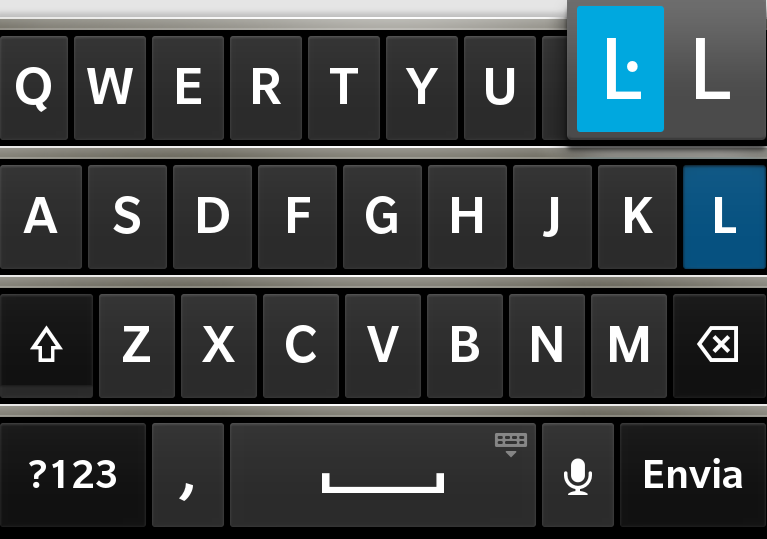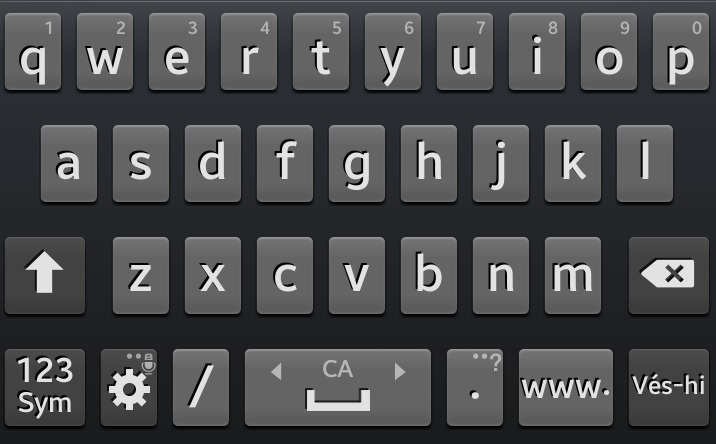
TouchKeyboard (en)
The issue around Catalan keyboard layout
- There is no official Catalan QWERTY PC keyboard layout. Standard Spanish (from Spain country) QWERTY layout is designed to type in Spanish, Catalan, Basque, Galician and Portuguese languages. So Catalan texts can be wrote with an Spanish keyboard.
- There is no official Catalan touch keyboard layout. Mobile OS’s like iOS, Android, FirefoxOS provide different Catalan touch keyboard layouts, but they are far to be a good design. There is room for improvement.
Needed characters for a Catalan keyboard layout
Catalan language uses a Latin based alphabet. Plain ASCII chars A-Z are used with few additional characters: À, È, É, Í, Ï, Ò, Ó, Ú, Ü, Ç, and · (U+00B7). Keep special attention to the character of the MIDDLEDOT “·” (U+00B7), which we’ll talk later.
Accented vowels are not considered different letters. They can be accessed as an alternative to the corresponding vowel, just as with the French or Spanish keyboards.
It’s better to provide Ç with an own key in the middle row, at right of L key. It takes the position that usually has Ñ key in Spanish layout.
Catalan users live in a multilingual environment. Street and family names, trademarks are wrote in Catalan, Spanish and English. For instance, it’s easy to find a text in Catalan language with an Spanish family name, like “Ibáñez”. So, a Catalan keyboard layout should provide all Spanish and French characters, and may be Portuguese and German too.
Catalan geminated el (L·L) and MIDDLEDOT · (U+00B7)
Catalan uses MIDDLEDOT “·” (U+00B7) as a diacritical inner-word character. It’s only typed between two L’s. There is an issue with a legacy character Ŀ (U+013F), lower-case ŀ (U+0140). There is an Unicode compatibility between Ŀ and “L·”. Preferred and widespread used encoding “L·”, with MIDDLEDOT · (U+00B7).
Surprisingly, MIDDLEDOT “·” char is not available on all keyboards on the market. Eg. Sony and Samsung don’t provide MIDLEDOT “·”.
Some Catalan keyboard layouts (iOS, pure Android,FirefosOS, Ubuntu Touch…) provide MIDDLEDOT “·” as an alternate to full-stop key “.”, and they also provide “L·L” string as an alternate to L key. That’s a very good approximation to facilitate good “L·L” encoding.
Hyphen – and apostrophe ‘
These two characters are very used in Catalan language, they are used in a similar way by French as “word joiners”. For instance, English sentence “Give me that” is translated in Catalan as “Dóna-m’ho”.
Few Catalan keyboards provide a quick introduction of the two characters. In social networks, it’s easy to see texts with comma “,” incorrectly used as apostrophe ‘. Eg., text like “m,han dit” appears instead correct one “m’ha dit”. Such behaviour proves a bad Catalan layout design (or a very lazy users community).
It is highly recommended that Catalan layout facilitates the introduction of the hyphen and apostrophe. We suggest two options to achieve this target, both options improve Catalan layout:
- Option A: create 2 new keys
-
- Add a 11th key by row. This allows the creation of 3 keys: hyphen, apostrophe and a free one (may be a question mark ?). This option is used by FirefoxOS Catalan layout (See below).
- Option B: provide hyphen and apostrophe as alternate chars for 2 other existing keys.
-
- Add hyphen as alternate for G key and add apostropheas alternate for V key. This option is used by Swiftkey and Adaptxt Catalan layouts (See below).
Quotation marks
Catalan uses angled quotation marks: «…». It is recommended that Catalan layout provides an easy access to them from the primary keyboard. For example, as alternate chars to the apostrophe key ‘, if it exists, or in the same location of straight/typewriter quotation mark “.
Current status about Catalan keyboard layouts
- Apple iOS Catalan keyboard layout:

-
- It provides “·” as alternate for normal dot key “.” and “L·L” as alternate for L key. It’s right.
- It provides diacritical chars for other languages (Spanish, French…). It’s right.
- It doesn’t make easy typing hyphen and apostrophe chars. It’s wrong.
- It doesn’t provide an own key for Ç. It’s not good, but a minor question.
- AOSP (pure Android) Catalan keyboard layout (Catalan Google Android keyboard too):

-
- It provides “·” as alternate for normal dot key “.” and “L·L” as alternate for L key. It’s right.
- It provides diacritical chars for other languages (Spanish, French…). It’s right.
- It doesn’t make easy typing hyphen and apostrophe chars. It’s wrong.
- Microsoft Windows Phone 8 Catalan keyboard layout:

-
- It provides “Ŀ” (U+013F)as alternate char for L key. It’s wrong.
- It doesn’t provide diacritical chars for other languages (Spanish, French…). It’s wrong.
- It doesn’t make easy typing hyphen and apostrophe chars. It’s wrong.
- BlackBerry OS 10 Catalan keyboard layout:

-
- It provides “Ŀ” (U+013F)as alternate char for L key. It’s wrong.
- It doesn’t provide an easy way to type hyphen and apostrophe chars. It’s wrong.
- It doesn’t provide diacritical chars for other languages (Spanish, French…). It’s wrong.
- It doesn’t provide an own key for Ç char. It’s not good, but a minor question.
- FirefoxOS Catalan keyboard layout:

-
- It provides “·” as alternate for normal dot key “.” and “L·L” as alternate for L key. It’s right.
- It provides diacritical chars for other languages (Spanish, French…). It’s right.
- It provides an easy way to type hyphen and apostrophe chars. It’s right.
- Ubunt Touch Catalan keyboard layout:

-
- It provides “·” as alternate for normal dot key “.” and “L·L” as alternate for L key. It’s right.
- It provides diacritical chars for other languages (Spanish, French…). It’s right.
- It doesn’t make easy typing hyphen and apostrophe chars. It’s wrong.
- Sony Catalan keyboard layout for Android/Xperia:
-
- It doesn’t provide any way to type “·” neither “L·L”. It’s wrong.
- It doesn’t make easy typing hyphen and apostrophe chars. It’s wrong.
- It doesn’t provide diacritical chars for other languages (Spanish, French…). It’s
- Samsung Catalan keyboard layout for Android/Galaxy:

-
- It doesn’t provide any way to type “·” char, neither “L·L”. It’s wrong.
- It doesn’t make easy typing hyphen and apostrophe chars. It’s wrong.
- It doesn’t provide diacritical chars for other languages (Spanish, French…). It’s
- It doesn’t provide an own key for Ç. It’s not good, but a minor question.
- Swiftkey Catalan keyboard layout:

-
- It provides all Catalan required chars. It’s right.
- It provides an easy way to type hyphen and apostrophe. Hyphen is available as alternate to G key, and apostrophe is in the V key. It’s right.
- It provides diacritical chars for other languages (Spanish, French…). It’s right.
- It doesn’t provide an own key for Ç. It’s not good, but a minor question.
- It provides “·” as alternate for Ç key. It isn’t the best option and it can be improved.
- Adaptxt Catalan keyboard layout:
-
- It provides all Catalan required chars. It’s right.
- It provides an easy way to type hyphen and apostrophe. It’s right.
- It provides diacritical chars for other languages (Spanish, French…). It’s right.
- It provides “·” as alternate for Ç key. It isn’t the best option and it can be improved.
- Swype Catalan keyboard layout:

-
- It provides all Catalan required chars. It’s right.
- It provides an easy way to type hyphen and apostrophe. Hyphen is available as alternate to comma key, and apostrophe is in the period key. It isn’t the best option and it can be improved.
- It provides diacritical chars for other languages (Spanish, French…). It’s right.
- It provides “·” as alternate for Ç key. It isn’t the best option and it can be improved.
Summary
- Every manufacturer provides a different Catalan keyboard layout.
- Several manufacturers have issues around MIDDLEDOT “·” availability and providing easy access for hyphen “-” and apostrophe “‘”.
- Some manufacturers don’t provide characters needed for other languages (Spanish, French..). These characters are needed for Catalan users in a daily use.